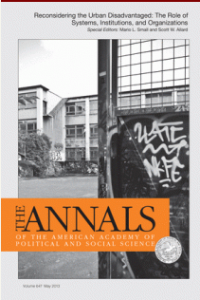Sept. 30, 2013
 The Annals of the American Academy of Political and Social Science, published an article in May of 2013, addressing a critical issue, “Can Drug Courts Help to Reduce Prison and Jail Populations?” [click on image on the left for a PDF of the article]. Written by Eric L. Sevigny, Harold A. Pollack, and Peter Reuter, the article was recently analyzed in a University of Chicago Urban Network, issue, which concluded, ” drug courts have significant capacity constraints and so cannot handle the full number of drug offenders; the eligibility criteria for participating is very strict, most significantly barring anyone with a current or prior violent offense; many participants fail to complete their therapy, and so end up in jail or prison anyway; and sentencing laws such as mandatory minimums or habitual offender statutes prevent offenders from participating.”
The Annals of the American Academy of Political and Social Science, published an article in May of 2013, addressing a critical issue, “Can Drug Courts Help to Reduce Prison and Jail Populations?” [click on image on the left for a PDF of the article]. Written by Eric L. Sevigny, Harold A. Pollack, and Peter Reuter, the article was recently analyzed in a University of Chicago Urban Network, issue, which concluded, ” drug courts have significant capacity constraints and so cannot handle the full number of drug offenders; the eligibility criteria for participating is very strict, most significantly barring anyone with a current or prior violent offense; many participants fail to complete their therapy, and so end up in jail or prison anyway; and sentencing laws such as mandatory minimums or habitual offender statutes prevent offenders from participating.”
I have addressed these issues in the past, and believe that it is important to provide a response. I agree with much of the criticism, I also believe that the writers and reviewers miss the main issue concerning the limitations regarding drug court outreach. Drug Courts are not intended to deal with all drug abusers, only the most serious drug users, those with a dependence upon drugs. It is generally understood that they are a small minority of those who use drugs and those who find themselves facing criminal charges involving drug abuse. I have seen estimates of those who use but are not addicted to drugs to be as high as 90% of the drug using population. If we expect drug courts to deal with those who are non-dependent on drugs, to be handled within a drug court we need to rethink the very concept of a drug court.
That is not to say that we should ignore the drug usage of those who are non -addicted, but make sure we are dealing with their dependence as part of a larger response to their criminal behavior. We need to do appropriate risk and needs assessments of all offenders (or at least all felony offenders) and handle their cases in a rational manner, and that means their drug issue, as serious as it is determined to be, by clinical and scientific evaluation. For the vast majority of drug offenders, (who are not drug dependent), that means that drugs are a second tier need, and that issues concerning their attitudes as to criminality, family and friends are far more important.
To repeat a tired phrase; Drug Court has become the proverbial lonely hammer in a tool belt, used because that’s all we have to use in our struggle against drug abuse and criminality. We are unable to develop a more nuanced and effective way to deal with the drug offender and their criminality, so we put them in drug court.Those who have the greatest need, the serious and dependent drug offender (often with a serious criminal history) are refused entrance because they are criminals. Isn’t that the population we were most concerned about providing effective rehabilitation for in the first place.
While the authors are right in complaining that drug courts are not reaching the vast majority of drug abusers, they are wrong to suggest that that is the population that drug courts need to engage. We need to develop evidence-based sentencing systems that provide appropriate responses to criminogenic needs, not dump all drug users into the same dumpster [See: A Model Court-Based Sentencing System]

